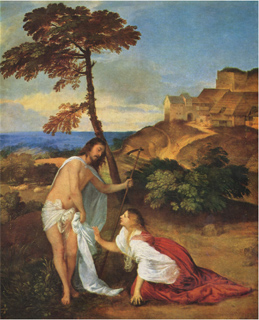What was it like on the very first Easter morning, when Mary Magdalene found herself face to face with the risen Christ? Titian’s Noli me tangere is a dramatic reconstruction of events described in the Gospel according to St John. Mary Magdalen, distraught at the disappearance of Christ’s body from the sepulchre, turns to find Jesus standing beside her. She takes him for the gardener, until he speaks her name and she suddenly realises who he is. She reaches out to touch him, but, as the Bible has it, “Jesus saith unto her, Touch me not; for I am not yet ascended to my father; but go to my brethren, and say unto them, I ascend unto my father, and your father, and to my God, and your God.”
Titian took a certain amount of licence as he set out (circa 1510-15) to put flesh on the bones of the biblical narrative. He replaced the original setting in Palestine with a fertile stretch of Northern Italian landscape somewhere in the Veneto; and he recast the heroine of the story, making her a thoroughly modern Magdalen, fashionably coiffed and wearing a high-waisted red dress of the sort deemed all the rage in Venice at the time.
The artist has painted the moment when Jesus tells the Magdalen not to touch him: “Noli me tangere”. From now on she must love the resurrected Christ not as man, but as God. This is a hard lesson for her. When she was a sinner, the Bible tells us, her sins were of the flesh. Even now that she has redeemed herself her first impulse is to honour his body, as she did once before, when she washed Christ’s feet with her tears and dried them with her hair. She has come to...

ITP 1: Noli me Tangere, by Titian
23-04-2000

